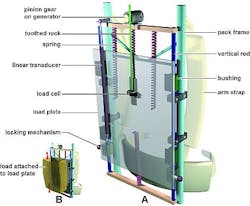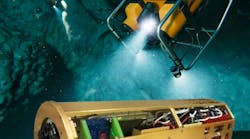NATICK, Mass., 17 Oct. 2012. U.S. Army researchers are helping refine a special backpack technology that enables infantry soldiers to generate electricity in small amounts as they walk, run, or otherwise operate in the field.
The Army Natick Soldier Systems Center in Natick, Mass., is awarding a contract potentially worth $2.4 million to Lightning Packs LLC in Strafford, Pa., to develop soldier-borne energy-harvesting technology for infantry soldiers and small combat units.
Lightning Packs specializes in a quiet, lightweight backpack design that generates electricity by tapping into the up-and-down energy that people generate when they walk.
The company's backpack technology can generate as much as 7.4 Watts of electricity when the wearer is walking -- enough to power or recharge an MP3 player, night-vision goggles, three-LED headlamp, handheld computer, CMOS image decoder, or handheld GPS, Lightning Packs officials say.
Natick announced the contract to Lightning Packs last week as part of a Warrior Systems Technology research program that seeks to develop energy-harvesting power sources for the foot soldier and small combat unit.
The exact amount of the contract has not been specified, but officials say it will be between $1.2 million and $2.4 million. Other services also are interested in the Lightning Packs energy-generating backpack technology.
Two years ago the U.S. Office of Naval Research (ONR) in Arlington, Va., awarded Lightning Packs a contract to refine the design, reduce the noise, and reduce the weight of the company's energy-generating backpack technology called Suspended Load Backpack.
This design has the rigid frame of a normal hiking backpack, yet suspends its load from the frame on vertical springs attached to a generator. The load moves up and down as the wearer walks, which activates the generator and makes the load easier to carry.
The Suspended Load Backpack is the invention of Dr. Lawrence C. Rome, a professor of biology at the University of Pennsylvania and a Whitman Investigator at the Marine Biological Laboratory in Woods Hole, Mass.
Rome and his colleagues envision a backpack for soldiers, Marines, first responders, and even children on the way to school to help lighten loads and generate electricity for portable devices.
More information about the contract is online at http://www.fbodaily.com/archive/2012/10-October/14-Oct-2012/FBO-02912894.htm. For additional information contact Lightning Backpacks online at www.lightningpacks.com, or the Army Natick Soldier Systems Center at www.army.mil/natick.
Follow Military & Aerospace Electronics and Avionics Intelligence news updates on Twitter




